罗宾斯管理学第六章练习题
- 格式:doc
- 大小:115.00 KB
- 文档页数:21

罗宾斯《管理学》第九版题库-6Chapter 6 –Decision-Making: The Essence of the Manager’s JobTrue/False Questions4. The first step in the decision-making process is identifyinga problem.True (easy)6. It is possible at the end of the decision-making process that you may be required to start the decisionprocess over again.True (easy)10. Decision-making is synonymous with managing.True (easy)12. One assumption of rationality is that we cannot know all of the alternatives.False (difficult)13. Accepting solutions that are "good enough" is termed satisfying.False (easy)15. Managers regularly use their intuition in decision-making.True (easy)16. Rational analysis and intuitive decision-making are complementary.True (moderate)18. Programmed decisions tend to be repetitive and routine.True (easy)21. Most managerial decisions in the real world are fully nonprogrammed.False (easy)24. Risk is a situation in which a decision maker has neither certainty nor reasonable probability estimates.False (difficult)25. An optimistic manager will follow a maximin approach.False (moderate)Multiple ChoiceTHE DECISION-MAKING PROCESS34. A series of eight steps that begins with identifying a problem and decision criteria and allocating weights to those criteria; moves to developing, analyzing, and selecting an alternative that can resolve the problem;implements the alternative; and concludes with evaluating the decision's effectiveness is the ______________.a. decision-making process. (easy)b. managerial process.c. maximin style.d. bounded rationality approach.e. legalistic opportunism process.36. "A discrepancy between an existing and a desired state of affairs" describes which of the steps in thedecision-making process?a. criteria weight allocationb. analysis of alternativesc. problem identification (difficult)d. decision effectiveness evaluatione. decision criteria identification38. Which of the following must be present in order to initiate the decision-making process?a. plenty of timeb. pressure to act (moderate)c. a lack of authorityd. a lack of resourcese. environmental certainty39. Managers aren't likely to characterize something as a problem if they perceive ______________.a. they don't have authority to act. (difficult)b. pressure to act.c. a discrepancy.d. they have sufficient resources.e. they have budgetary authority.44. Selecting an alternative in the decision-making process is accomplished by ______________.a. choosing the alternative with the highest score. (easy)b. choosing the one you like best.c. selecting the alternative that has the lowest price.d. selecting the alternative that is the most reliable.e. choosing the alternative you think your boss would prefer.47. Which of the following is the final step in the decision-making process?a. identifying the problemb. evaluating the decision's effectiveness (easy)c. identifying decision criteriad. selecting an alternative that can resolve the probleme. allocating weights to alternatives.48.Which of the following is important to remember in evaluating the effectiveness of the decision-makingprocess?a. Ignore criticism concerning the decision-making.b. You may have to start the whole decision process over.(difficult)c. Restart the decision-making process if the decision is less than 50% effective.d. 90% of problems with decision-making occur in the implementation step.e. Keep track of problems with the chosen alternative, but only change those issues that uppermanagement demand.49. Decision-making is synonymous with ______________.a. managing. (easy)b. leading.c. controlling.d. planning.e. organizing.51. Which of the following is not an "organizing" decision?a. What are the organization's long-term objectives? (moderate)b. How many employees should I have report directly to me?c. How should jobs be designed?d. How much centralization should there be in the organization?e. When should the organization implement a different structure?52. Which of the following is not a "leading" decision?a. How do I handle employees who appear to be low in motivation?b. What is the most effective leadership style in a given situation?c. How will a specific change affect worker productivity?d. When is the right time to stimulate conflict?e. How should jobs be designed? (moderate)53. Which of the following is not a "controlling" decision?a. What activities in the organization need to be controlled?b. How should those activities be controlled?c. When is a performance deviation significant?d. When is the right time to stimulate conflict? (moderate)e. What type of management information system should the organization have?54. Managers are assumed to be ______________; they make consistent, value-maximizing choices withinspecified constraints.a. rational (easy)b. leadersc. organizedd. satisficerse. programmed57. Which of the following is not a valid assumption about rationality?a. The problem is clear and unambiguous.b. A single well-defined goal is to be achieved.c. Preferences are clear.d. Preferences are constantly changing. (difficult)e. No time or cost constraints exist.58. In "bounded rationality," managers construct ______________ models that extract the essential features from problems.a. multipleb. bindingc. interactived. simplified (difficult)e. past59. According to the text, because managers can’t possibly analyze all information on all alternatives, managers______________, rather than ______________.a.maximize; satisficeb.maximize; minimizec.satisfice; minimized.satisfice; maximize (moderate)62. An increased commitment to a previous decision despite evidence that it may have been wrong is referredto as _____________.a.economies of commitmentb.escalation of commitment (moderate)c.dimensional commitmentd.expansion of commitment64. According to the text, all of the following are aspects of intuition EXCEPT:a.experienced-based decisionsb.affect-initiated decisionsc.cognitive-based decisionsd.values or ethics-based decisionse.programmed decisions (easy)65.According to the text, _____________ are straightforward, familiar, and easily defined problems.a.poorly-structured problemsb.well-structured problems (moderate)c.unique problemsd.non-programmed problemse.programmed problems68. ______________ decision-making is relatively simple andtends to rely heavily on previous solutions.a. Nonprogrammedb. Linearc. Satisficingd. Integrativee. Programmed (moderate)70. A ______________ is a series of interrelated sequential steps that a manager can use for responding to astructured problem.a. procedure (easy)b. rulec. policyd. systeme. solution71. A ______________ is an explicit statement that tells a manager what he or she ought or ought not to do.a. procedureb. policyc. rule (moderate)d. solutione. system72. A ______________ provides guidelines to channel a manager's thinking in a specific direction.a. systemb. rulec. solutiond. policy (moderate)e. procedure75. A business school's statement that it "strives for productive relationships with local organizations," is anexample of a ______________.a. rule.b. policy. (moderate)c. procedure.d. commitment.e. contract.78. Which of the following terms is associated with nonprogrammed decisions?a. unique (moderate)b. recurringc. routined. repetitivee. well-defined79. Lower-level managers typically confront what type of decision-making?a. uniqueb. nonroutinec. programmed (moderate)d. nonprogrammede. nonrepetitive83. If an individual knows the price of three similar cars at different dealerships, he/she is operating under what type of decision-making condition?a. riskb. uncertaintyc. certainty (easy)d. factuale. unprogrammed84. ______________ is those conditions in which the decision maker is able to estimate the likelihood ofcertain outcomes.a. Certaintyb. Risk (easy)c. Uncertaintyd. Maximaxe. Maximin85. A retail clothing store manager who estimates how much to order for the current spring season based on lastspring's outcomes is operating under what kind of decision-making condition?a. seasonalb. risk (difficult)c. uncertaintyd. certaintye. cyclical86. ______________ is a situation in which a decision maker has neither certainty nor reasonable probabilityestimates available.a. Certaintyb. Riskc. Uncertainty (easy)d. Maximaxe. Maximin87. A person at a horse racetrack who bets all of his/her money on the odds-based longshot to "win" (ratherthan "place" or "show") is making what kind of choice?a. maximax (moderate)b. maximinc. minimaxd. minimin89. An individual making a "maximin" type of choice has what type of psychological orientation concerninguncertain decision-making?a. optimistb. realistc. pessimist (moderate)d. satisficere. extremist91. According to the text, a manager who desires to minimize his or her maximim “regret” will opt for a______________ choice.a. maximaxb. maximinc. minimax (moderate)d. minimin93. Which of the following decision-making styles have low tolerance for ambiguity and are rational in theirway of thinking?a.directive (moderate)b.egotisticalc.analyticd.conceptuale.behavioral95. The decision-making style that makes fast decisions and focuses on the short terms is referred to as the______________ style.a.directive (moderate)b.egotisticalc.analyticd.conceptuale.behavioral98. According to the text, ______________ are best characterized as careful decision makers with the ability to adapt or cope with unique situations.a. conceptualb. behavioralc. empiricald. analytic (moderate)e. spatial99. Which of the following is the decision-making style that would most likely look at as many alternatives aspossible and focus on the long run?a. analyticalb. directivec. conceptual (moderate)d. behaviorale. spatial101. A manager who would decide what computer system to purchase for the department by holding a meeting and receiving feedback from his/her subordinates matches with which type of decision-making style?a. analyticalb. behavioral (difficult)c. conceptuald. directivee. empiricalScenariosDecision-Making Conditions (Scenario)Sandy Jo is the manager for TrucksRUs, a medium-sized hauling service located in the Southeast. She is responsible forscheduling trucks, initiating new routes, and staffing both existing and new routes. She is currently struggling with existing information about the profitability of existing and future truck routes.116. Bubba, Sandy Jo's best driver tells her that he believes that he can estimate that there is a 75% probability that they can get the business of Pork Brothers Inc. if they initiate a truck route through rural North Carolina. Bubba is operating under a condition of ______________.a. certainty.b. risk. (difficult)c. uncertainty.d. maximax.e. maximin.117. Sandy Jo can make accurate decisions if she is willing to pay $5,000 for research about the profitability of various truck routes. If she pays for the research, she believes that she is operating under a condition of ______________.a. certainty. (difficult)b. risk.c. uncertainty.d. maximax.e. maximin.118. Sandy Jo knows that she is operating in an uncertain environment. She is basically an optimist, and we would, therefore, expect her to follow a ______________ strategy.a. certaintyb. riskc. uncertaintyd. maximax (moderate)e. maximin119. Sandy Jo knows that she is operating in an uncertain environment. She is basically a pessimist, and we would, therefore, expect her to follow a ______________ strategy.a. certaintyb. riskc. minimaxd. maximaxe. maximin (moderate)120. Sandy Jo wishes to minimize her regret and will probably opt for a ______________ strategy.a. certainty.b. risk.c. minimax (moderate)d. maximax.e. maximin.Essay QuestionsTHE DECISION-MAKING PROCESS121. In a short essay, list and discuss the eight steps in the decision-making process.Answera.Step 1: Identifying a problem– the decision-making process begins with t he existence of a problem ora discrepancy between an existing and a desired state of affairs.However, a discrepancy withoutpressure to take action becomes a problem that can be postponed.b.Step 2: Identify decision criteria–once the manager has identified a problem that needs attention, thedecision criteria important to resolving the problem must beidentified. That is, managers must determine what’s relevant in making a decision.c.Step 3: Allocating weights to the criteria: at this step, the decision maker must weigh the items inorder to give them the correct priority in the decision. A simple approach is to give the most important criterion a weight of 10 and then assign weights to the rest against that standard.d.Step 4: Developing alternative s –the fourth step requires the decision maker to list the viablealternatives that could resolve the problem. No attempt is made in this step to evaluate the alternative, only to list them.e.Step 5: Analyzing alternative s – once the alternatives have been identified, the decision maker mustcritically analyze each one. From this comparison, the strengths and weaknesses of each alternative become evident.f.Step 6: Selecting an alternative–the sixth step is the important act of choosing the best alternative fromamong those considered. All the pertinent criteria in the decision have now been determined, weighted, and the alternatives have been identified and analyzed.g.Step 7: Implementing the alternativ e –implementation involves conveying the decision to thoseaffected by it and getting their commitment to it. If the people who must carry out a decision participate in the process, they’re more likely to enthusiastically support the outcome than if they are just told what to do.h.Step 8: Evaluating decision effectiveness –the last step in the decision-making process involvesappraising the outcome of the decision to see if the problem has been resolved. Did the alternative chose and implementedaccomplish the desired result? If not, the manager may consider returning to a previous step or may even consider starting the whole decision process over.(difficult)123. In a short essay, discuss the assumptions of rationality and the validity of those assumptions.AnswerA decision maker who was perfectly rational would be fully objective and logical. He or she wouldcarefully define a problem and would have a clear and specific goal. Moreover, making decisions using rationality would consistently lead toward selecting the alternative that maximizes the likelihood of achieving that goal. The assumptions of rationality apply to any decision. Rational managerial decision making assumes that decisions are made in the best economic interests of the organization. That is, the decision maker is assumed to be maximizing the organization’s interests, not his or her own interests.Managerial decision making can follow rational assumptions if the following conditions are met: The manager is faced with a simple problem in which the goals are clear and the alternatives limited, in which the time pressures are minimal and the cost of seeking out and evaluating alternatives is low, for which the organizational culture supports innovation and risk taking, and in which o utcomes are relatively concrete and measurable. However, most decisions that managers face in the real world d on’t meet all those tests.(moderate)126. In a short essay, discuss the difference between well-structured and poorly structured problems. Include specificexamples of each type of problem to support your answer. Next discuss the type of decisions that would be used to address each of these problems.Answera.Well-structured problems - the goal of the decision marker is clear, the problem is familiar, andinformation about the problem is easily defined and complete. Examples of these types of problems might include a customer’s wanting to return a purchase to a retail store, a supplier’s being late with an important delivery, a news team’s responding to an unexpected and fast-breaking event, or a college’s handling of a student wanting to drop a class. Such situations are called well-structured problems since they are straightforward, familiar, and easily defined problems. In handling these problem situations, the manager uses a programmed decision. Decisions are programmed to the extent that they are repetitive and routine a nd to the extent that a definite approach has been worked out for handling them.Because the problem is well structured, the manager doesn’t have to go to the trouble and expense of going through an involved decision progress. Programmed decision making is relatively simple and tends to rely heavily on previous solutions.b.Poorly-structured problems –these problems are new or unusual and for which information isambiguous or incomplete.For example, the selection of an architect to design a new corporate manufacturing facility in Bangkok is an example of a poorly-structured problem. When problems are poorly-structured, managers must rely on nonproprammed decision making in order to develop unique solutions.Nonprogrammed decisions are unique andnonrecurring. When a manager confronts a poorly-structured problem, or one that is unique, there is no cut-and-dried solution. It requires a custom-made response through nonprogrammed decision making.(difficult)130. In a short essay, list and discuss the four decision-making styles as described in the text.Answera.Directive style – people using the directive style have low tolerance for ambiguity and are rational intheir way of thinking. They’re efficient and logical. Directive types make fast decisions and focus on the short run. Their efficiency and speed in making decisions often result in their making decisions with minimal information and assessing few alternatives.b.Analytic style – decision-makers with an analytic style have much greater tolerance for ambiguity thando directive types. They want more information before making a decision and consider more alternatives than a directive style decision-maker does. Analytic decision-makers are best characterized as careful decision-makers with the ability to adapt or cope with unique situations.c.Conceptual style – individuals with a conceptual style tend to be very broad in their outlook and willlook at many alternatives. They focus on the long run and are very good at finding creative solutions to problems.d.Behavioral style –these decision markers work well with others. They’re concerned about theachievements of subordinates and are receptive to suggestions from others. They often use meetings tocommunicate, although they try to avoid conflict. Acceptance by others is important to this decision-making style.(moderate)。
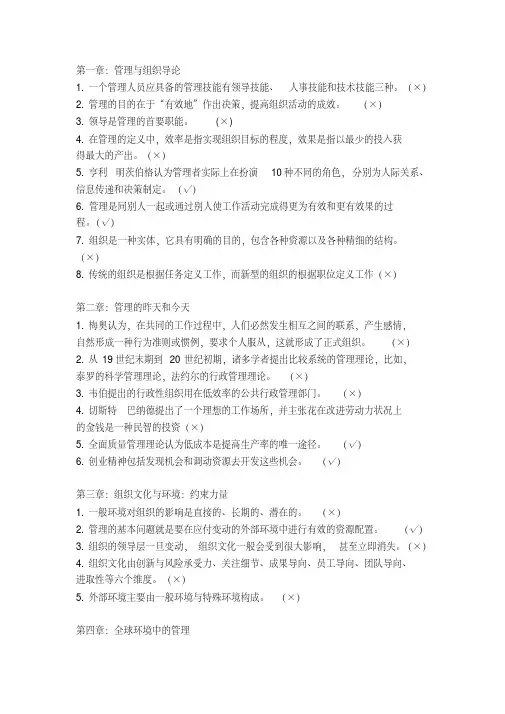
第一章:管理与组织导论1. 一个管理人员应具备的管理技能有领导技能、人事技能和技术技能三种。
(×)2. 管理的目的在于“有效地”作出决策,提高组织活动的成效。
(×)3. 领导是管理的首要职能。
(×)4. 在管理的定义中,效率是指实现组织目标的程度,效果是指以最少的投入获得最大的产出。
(×)5. 亨利·明茨伯格认为管理者实际上在扮演10种不同的角色,分别为人际关系、信息传递和决策制定。
(√)6. 管理是同别人一起或通过别人使工作活动完成得更为有效和更有效果的过程。
(√)7. 组织是一种实体,它具有明确的目的,包含各种资源以及各种精细的结构。
(×)8. 传统的组织是根据任务定义工作,而新型的组织的根据职位定义工作(×)第二章:管理的昨天和今天1.梅奥认为,在共同的工作过程中,人们必然发生相互之间的联系,产生感情,自然形成一种行为准则或惯例,要求个人服从,这就形成了正式组织。
(×)2.从19世纪末期到20世纪初期,诸多学者提出比较系统的管理理论,比如,泰罗的科学管理理论,法约尔的行政管理理论。
(×)3. 韦伯提出的行政性组织用在低效率的公共行政管理部门。
(×)4. 切斯特·巴纳德提出了一个理想的工作场所,并主张花在改进劳动力状况上的金钱是一种民智的投资(×)5. 全面质量管理理论认为低成本是提高生产率的唯一途径。
(√)6. 创业精神包括发现机会和调动资源去开发这些机会。
(√)第三章:组织文化与环境:约束力量1. 一般环境对组织的影响是直接的、长期的、潜在的。
(×)2. 管理的基本问题就是要在应付变动的外部环境中进行有效的资源配置。
(√)3. 组织的领导层一旦变动,组织文化一般会受到很大影响,甚至立即消失。
(×)4. 组织文化由创新与风险承受力、关注细节、成果导向、员工导向、团队导向、进取性等六个维度。
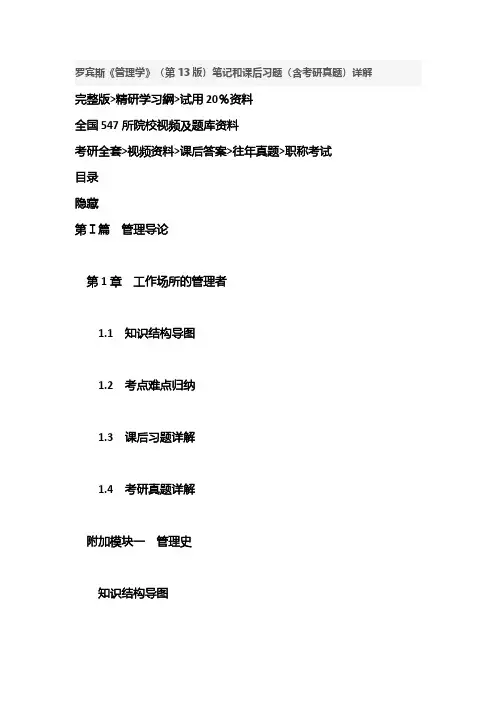
罗宾斯《管理学》(第13版)笔记和课后习题(含考研真题)详解完整版>精研学习䋞>试用20%资料全国547所院校视频及题库资料考研全套>视频资料>课后答案>往年真题>职称考试目录隐藏第Ⅰ篇管理导论第1章工作场所的管理者1.1知识结构导图1.2考点难点归纳1.3课后习题详解1.4考研真题详解附加模块一管理史知识结构导图考点难点归纳课后习题详解考研真题详解第2章决策2.1知识结构导图2.2考点难点归纳2.3课后习题详解2.4考研真题详解第Ⅰ篇管理实践第Ⅱ篇现代工作场所的管理基础知识第3章管理外部环境和组织文化3.1知识结构导图3.2考点难点归纳3.3课后习题详解3.4考研真题详解第4章全球环境下的管理4.1知识结构导图4.2考点难点归纳4.3课后习题详解4.4考研真题详解第5章管理多样性5.1知识结构导图5.2考点难点归纳5.3课后习题详解5.4考研真题详解第6章管理社会责任和道德6.1知识结构导图6.2考点难点归纳6.3课后习题详解6.4考研真题详解第7章管理变革和创新7.1知识结构导图7.2考点难点归纳7.3课后习题详解7.4考研真题详解第Ⅱ篇管理实践第Ⅲ篇计划第8章计划工作活动8.1知识结构导图8.2考点难点归纳8.3课后习题详解8.4考研真题详解第9章战略管理9.1知识结构导图9.2考点难点归纳9.3课后习题详解9.4考研真题详解附加模块二创办和领导创业型企业知识结构导图考点难点归纳课后习题详解考研真题详解第Ⅲ篇管理实践第Ⅳ篇组织第10章基本的组织结构设计10.1知识结构导图10.2考点难点归纳10.3课后习题详解10.4考研真题详解第11章适应性组织结构设计11.1知识结构导图11.2考点难点归纳11.3课后习题详解11.4考研真题详解第12章人力资源管理12.1知识结构导图12.2重点难点归纳12.3课后习题详解12.4考研真题详解附加模块三管理你的职业知识结构导图考点难点归纳第13章塑造和管理团队13.1知识结构导图13.2考点难点归纳13.3课后习题详解13.4考研真题详解第Ⅳ篇管理实践第Ⅴ篇领导第14章沟通管理14.1知识结构导图14.2考点难点归纳14.3课后习题详解14.4考研真题详解第15章理解和管理个体行为15.1知识结构导图15.2考点难点归纳15.3课后习题详解15.4考研真题详解第16章激励员工16.1知识结构导图16.2考点难点归纳16.3课后习题详解16.4考研真题详解第17章成为有效领导者17.1知识结构导图17.2考点难点归纳17.3课后习题详解17.4考研真题详解第Ⅴ篇管理实践第Ⅵ篇控制第18章监管和控制18.1知识结构导图18.2考点难点归纳18.3课后习题详解18.4考研真题详解附加模块四计划与控制技术知识结构导图考点难点归纳课后习题详解考研真题详解附加模块五运营管理知识结构导图考点难点归纳课后习题详解考研真题详解第Ⅵ篇管理实践内容简介隐藏本书是罗宾斯《管理学》(第13版)教材的学习辅导书,具体来说包括以下几大部分:(1)整理考试重难点,浓缩内容精华。
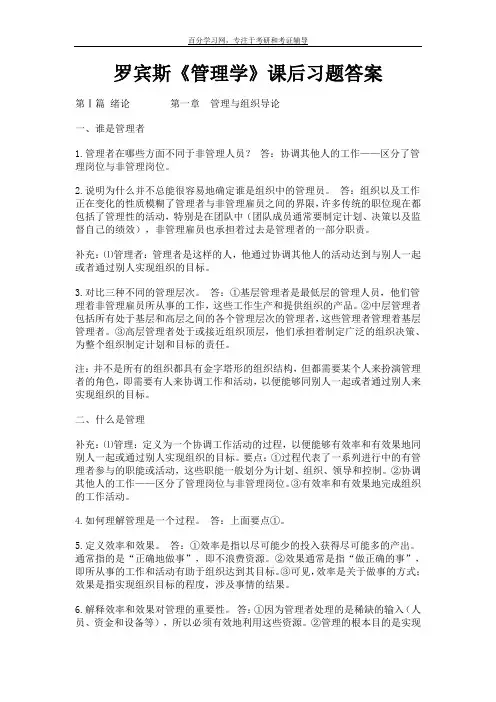
罗宾斯《管理学》课后习题答案第Ⅰ篇绪论第一章管理与组织导论一、谁是管理者1.管理者在哪些方面不同于非管理人员?答:协调其他人的工作——区分了管理岗位与非管理岗位。
2.说明为什么并不总能很容易地确定谁是组织中的管理员。
答:组织以及工作正在变化的性质模糊了管理者与非管理雇员之间的界限,许多传统的职位现在都包括了管理性的活动,特别是在团队中(团队成员通常要制定计划、决策以及监督自己的绩效),非管理雇员也承担着过去是管理者的一部分职责。
补充:⑴管理者:管理者是这样的人,他通过协调其他人的活动达到与别人一起或者通过别人实现组织的目标。
3.对比三种不同的管理层次。
答:①基层管理者是最低层的管理人员,他们管理着非管理雇员所从事的工作,这些工作生产和提供组织的产品。
②中层管理者包括所有处于基层和高层之间的各个管理层次的管理者,这些管理者管理着基层管理者。
③高层管理者处于或接近组织顶层,他们承担着制定广泛的组织决策、为整个组织制定计划和目标的责任。
注:并不是所有的组织都具有金字塔形的组织结构,但都需要某个人来扮演管理者的角色,即需要有人来协调工作和活动,以便能够同别人一起或者通过别人来实现组织的目标。
二、什么是管理补充:⑴管理:定义为一个协调工作活动的过程,以便能够有效率和有效果地同别人一起或通过别人实现组织的目标。
要点:①过程代表了一系列进行中的有管理者参与的职能或活动,这些职能一般划分为计划、组织、领导和控制。
②协调其他人的工作——区分了管理岗位与非管理岗位。
③有效率和有效果地完成组织的工作活动。
4.如何理解管理是一个过程。
答:上面要点①。
5.定义效率和效果。
答:①效率是指以尽可能少的投入获得尽可能多的产出。
通常指的是“正确地做事”,即不浪费资源。
②效果通常是指“做正确的事”,即所从事的工作和活动有助于组织达到其目标。
③可见,效率是关于做事的方式;效果是指实现组织目标的程度,涉及事情的结果。
6.解释效率和效果对管理的重要性。
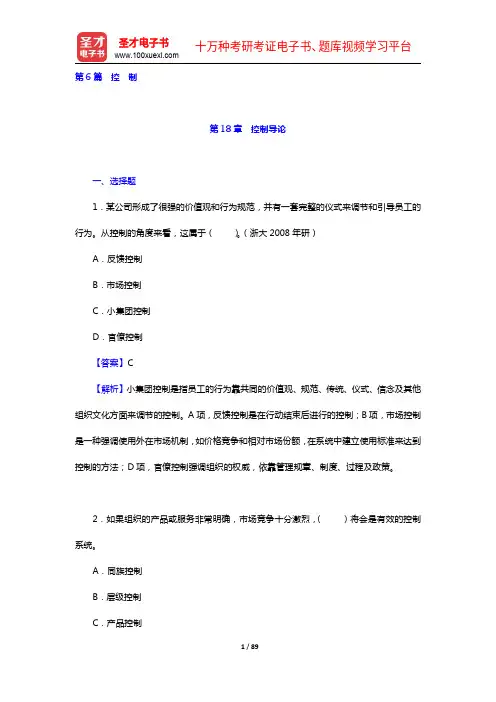
第6篇控制第18章控制导论一、选择题1.某公司形成了很强的价值观和行为规范,并有一套完整的仪式来调节和引导员工的行为。
从控制的角度来看,这属于()。
(浙大2008年研)A.反馈控制B.市场控制C.小集团控制D.官僚控制【答案】C【解析】小集团控制是指员工的行为靠共同的价值观、规范、传统、仪式、信念及其他组织文化方面来调节的控制。
A项,反馈控制是在行动结束后进行的控制;B项,市场控制是一种强调使用外在市场机制,如价格竞争和相对市场份额,在系统中建立使用标准来达到控制的方法;D项,官僚控制强调组织的权威,依靠管理规章、制度、过程及政策。
2.如果组织的产品或服务非常明确,市场竞争十分激烈,()将会是有效的控制系统。
A.同族控制B.层级控制C.产品控制D.市场控制【答案】D【解析】三种控制系统的特征:①市场控制是一种强调使用外在市场机制,如价格竞争和相对市场份额,在系统中建立使用标准来达到控制的方法。
在这种情况下,公司的部门常常调整为利润中心,评价的标准是各自对公司利润贡献的百分比。
②官僚控制,它强调组织的权威,依靠管理规章、制度、过程及政策。
③小集团控制,员工的行为靠共同的价值观、规范、传统、仪式、信念及其他组织文化方面的东西来调节。
3.Z公司在将制造环节外包给某地一家企业时,为了防止潜在的质量问题,在生产线还没有建成之前就开始培训对方的工艺技术人员和质量检验人员。
从控制的角度来看,这属于()。
(浙大2007年研)A.反馈控制B.现场控制C.前馈控制D.同期控制【答案】C4.关于组织控制,下列哪种说法是正确的?()A.有效的控制系统有利于员工的授权B.制定组织结构对于控制活动非常关键C.人力资源管理属于控制职能D.组织的战略是在控制阶段制定的【答案】A【解析】许多管理者不愿意向自己的员工授权,因为他们害怕如果发生什么差错,将由他们来承担责任。
但是,一种有效的控制系统能够对员工绩效提供相关信息和反馈,从而使发生潜在问题的几率降至最低。

罗宾斯《管理学》(第13版)笔记和课后习题(含考研真题)详解完整版>精研学习䋞>试用20%资料全国547所院校视频及题库资料考研全套>视频资料>课后答案>往年真题>职称考试目录隐藏第Ⅰ篇管理导论第1章工作场所的管理者1.1知识结构导图1.2考点难点归纳1.3课后习题详解1.4考研真题详解附加模块一管理史知识结构导图考点难点归纳课后习题详解考研真题详解第2章决策2.1知识结构导图2.2考点难点归纳2.3课后习题详解2.4考研真题详解第Ⅰ篇管理实践第Ⅱ篇现代工作场所的管理基础知识第3章管理外部环境和组织文化3.1知识结构导图3.2考点难点归纳3.3课后习题详解3.4考研真题详解第4章全球环境下的管理4.1知识结构导图4.2考点难点归纳4.3课后习题详解4.4考研真题详解第5章管理多样性5.1知识结构导图5.2考点难点归纳5.3课后习题详解5.4考研真题详解第6章管理社会责任和道德6.1知识结构导图6.2考点难点归纳6.3课后习题详解6.4考研真题详解第7章管理变革和创新7.1知识结构导图7.2考点难点归纳7.3课后习题详解7.4考研真题详解第Ⅱ篇管理实践第Ⅲ篇计划第8章计划工作活动8.1知识结构导图8.2考点难点归纳8.3课后习题详解8.4考研真题详解第9章战略管理9.1知识结构导图9.2考点难点归纳9.3课后习题详解9.4考研真题详解附加模块二创办和领导创业型企业知识结构导图考点难点归纳课后习题详解考研真题详解第Ⅲ篇管理实践第Ⅳ篇组织第10章基本的组织结构设计10.1知识结构导图10.2考点难点归纳10.3课后习题详解10.4考研真题详解第11章适应性组织结构设计11.1知识结构导图11.2考点难点归纳11.3课后习题详解11.4考研真题详解第12章人力资源管理12.1知识结构导图12.2重点难点归纳12.3课后习题详解12.4考研真题详解附加模块三管理你的职业知识结构导图考点难点归纳第13章塑造和管理团队13.1知识结构导图13.2考点难点归纳13.3课后习题详解13.4考研真题详解第Ⅳ篇管理实践第Ⅴ篇领导第14章沟通管理14.1知识结构导图14.2考点难点归纳14.3课后习题详解14.4考研真题详解第15章理解和管理个体行为15.1知识结构导图15.2考点难点归纳15.3课后习题详解15.4考研真题详解第16章激励员工16.1知识结构导图16.2考点难点归纳16.3课后习题详解16.4考研真题详解第17章成为有效领导者17.1知识结构导图17.2考点难点归纳17.3课后习题详解17.4考研真题详解第Ⅴ篇管理实践第Ⅵ篇控制第18章监管和控制18.1知识结构导图18.2考点难点归纳18.3课后习题详解18.4考研真题详解附加模块四计划与控制技术知识结构导图考点难点归纳课后习题详解考研真题详解附加模块五运营管理知识结构导图考点难点归纳课后习题详解考研真题详解第Ⅵ篇管理实践内容简介隐藏本书是罗宾斯《管理学》(第13版)教材的学习辅导书,具体来说包括以下几大部分:(1)整理考试重难点,浓缩内容精华。
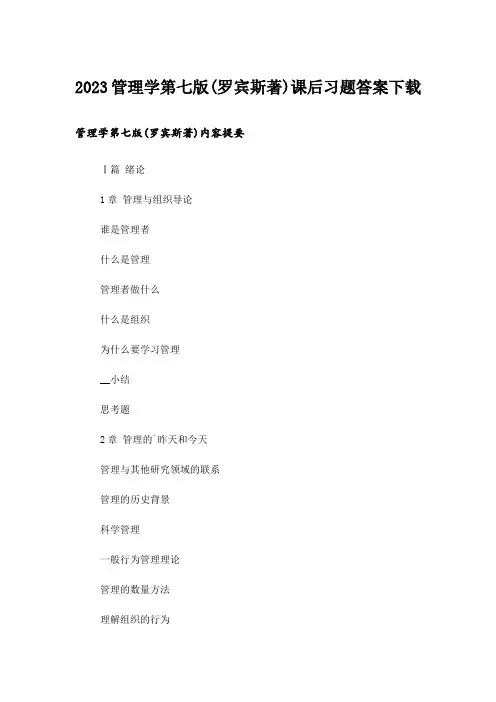
2023管理学第七版(罗宾斯著)课后习题答案下载管理学第七版(罗宾斯著)内容提要
Ⅰ篇绪论
1章管理与组织导论
谁是管理者
什么是管理
管理者做什么
什么是组织
为什么要学习管理
__小结
思考题
2章管理的`昨天和今天
管理与其他研究领域的联系
管理的历史背景
科学管理
一般行为管理理论
管理的数量方法
理解组织的行为
当前的趋势和问题
__小结
思考题
Ⅱ篇定义管理者的领地
3章组织文化与环境:约束力量
管理者:万能的还是象征性的
组织文化
环境
__小结
思考题
... [显示全部]
管理学第七版(罗宾斯著)图书目录
在中国管理学界和企业界,罗宾斯博士的《管理学》(第4版)毫无疑问是最受欢迎和采用量最大的教材,且连续数年畅销不衰。
但管理是一个动态的学科,关于管理的教科书也必须不断适应环境的巨大变化。
本书第7版在成功地保持了管理学四个基本功能的思路、内容和特征的基础上,增加了与经济全球化和信息化有关的电子商务、工作场所的精神、利益相关者关系管理、虚拟团队、团队建设、高绩效组织、价值链管理、工作与生活的平衡等大量现实世界的新专题和新特征,以便更好地反映管理领域中实践和研究的新发展,体现21世纪激动人心的管理。
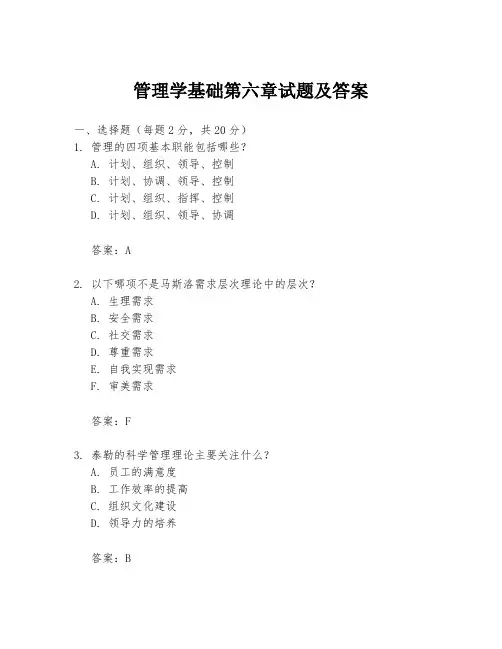
管理学基础第六章试题及答案一、选择题(每题2分,共20分)1. 管理的四项基本职能包括哪些?A. 计划、组织、领导、控制B. 计划、协调、领导、控制C. 计划、组织、指挥、控制D. 计划、组织、领导、协调答案:A2. 以下哪项不是马斯洛需求层次理论中的层次?A. 生理需求B. 安全需求C. 社交需求D. 尊重需求E. 自我实现需求F. 审美需求答案:F3. 泰勒的科学管理理论主要关注什么?A. 员工的满意度B. 工作效率的提高C. 组织文化建设D. 领导力的培养答案:B4. 以下哪个不是亨利·甘特的代表作?A. 《科学管理原理》B. 《工业工程》C. 《甘特图》D. 《管理的实践》答案:D5. 以下哪个理论不属于行为科学理论?A. 人际关系运动B. 系统理论C. 霍桑实验D. 双因素理论答案:B二、判断题(每题1分,共10分)1. 管理的目的是实现组织目标。
(对)2. 管理的科学性与艺术性是相互排斥的。
(错)3. 泰勒的科学管理理论认为,工人的工作效率可以通过科学方法来提高。
(对)4. 马斯洛的需求层次理论认为,人们总是先满足低层次的需求,然后再满足高层次的需求。
(对)5. 组织文化是组织内部成员共享的价值观、行为准则和传统。
(对)三、简答题(每题5分,共20分)1. 简述泰勒科学管理理论的主要内容。
答:泰勒的科学管理理论主要包括工作研究、科学选工、工作标准化、差别计件工资制和职能管理等,旨在通过科学方法提高工作效率。
2. 描述马斯洛需求层次理论的五个层次。
答:马斯洛需求层次理论包括生理需求、安全需求、社交需求、尊重需求和自我实现需求,从低到高依次排列。
3. 什么是双因素理论?答:双因素理论是由赫茨伯格提出的,认为工作满意度和不满意度是由两组不同的因素决定的,即卫生因素和激励因素。
4. 什么是组织文化?答:组织文化是指组织内部成员共享的价值观、信仰、行为准则、传统和工作方式等,它影响着组织成员的行为和决策。
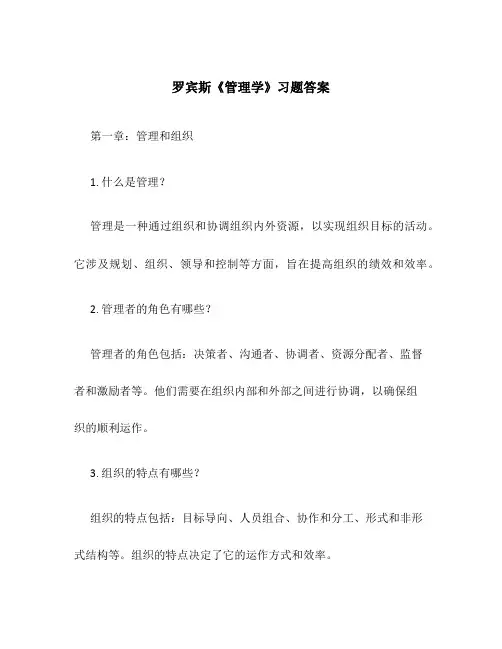
罗宾斯《管理学》习题答案第一章:管理和组织1. 什么是管理?管理是一种通过组织和协调组织内外资源,以实现组织目标的活动。
它涉及规划、组织、领导和控制等方面,旨在提高组织的绩效和效率。
2. 管理者的角色有哪些?管理者的角色包括:决策者、沟通者、协调者、资源分配者、监督者和激励者等。
他们需要在组织内部和外部之间进行协调,以确保组织的顺利运作。
3. 组织的特点有哪些?组织的特点包括:目标导向、人员组合、协作和分工、形式和非形式结构等。
组织的特点决定了它的运作方式和效率。
4. 什么是组织文化?组织文化是指组织内部共享的价值观、信念和行为方式。
它是组织的独特文化特征,对组织内部成员的行为和决策产生影响。
5. 管理学的历史和发展管理学的历史可以追溯到古代,但现代管理学的发展主要起源于20世纪初。
管理学逐渐形成了管理理论、管理原则和管理实践等体系,为组织管理提供了理论指导。
第二章:管理环境1. 管理环境的组成部分有哪些?管理环境包括内外环境。
内部环境由组织的员工、文化和结构等因素组成,而外部环境则包括政治、经济、社会和技术因素等。
管理者需要了解和适应环境的变化,以确保组织的成功。
经济环境对管理的影响主要表现为市场竞争、供求关系、通货膨胀和经济周期等方面。
管理者需要根据经济环境的变化,制定相应的策略和决策。
3. 技术环境对管理的影响有哪些?技术环境对管理的影响包括信息技术的发展、生产工艺的改进和自动化等方面。
管理者需要不断学习和应用新的技术,以提高组织的效率和竞争力。
4. 政治环境对管理的影响有哪些?政治环境对管理的影响主要表现为政府政策、法律法规和政府政策等方面。
管理者需要遵守相关法律法规,并与政府保持良好的关系。
除了经济、技术和政治环境外,管理者还需要考虑社会、文化、人口和环境等因素对管理的影响。
这些因素可以影响组织的形象和公众形象。
第三章:管理理论1. 传统管理理论有哪些?传统管理理论包括科学管理学、行政管理学和人际关系学。
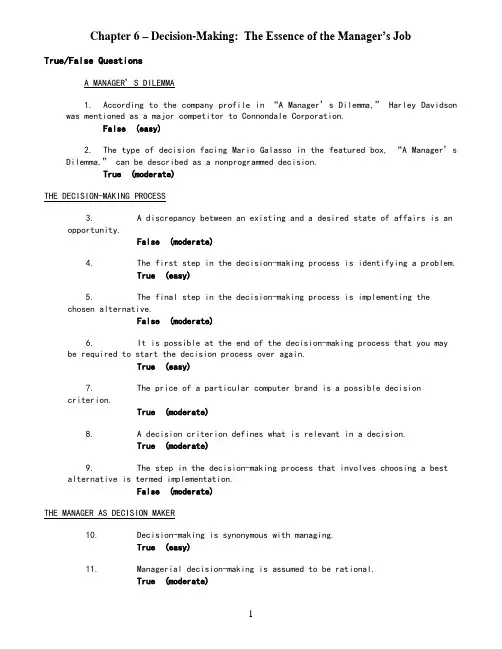
Chapter 6 – Decision-Making: The Essence of the Manager’s JobTrue/False QuestionsA MANAGER’S DILEMMA1. According to the company profile in “A Manager’s Dilemma,” Harley Davidsonwas mentioned as a major competitor to Connondale Corporation.False (easy)2. The type of decision facing Mario Galasso in the featured box, “A Manager’sDilemma,” can be described as a nonprogrammed decision.True (moderate)THE DECISION-MAKING PROCESS3. A discrepancy between an existing and a desired state of affairs is anopportunity.False (moderate)4. The first step in the decision-making process is identifying a problem.True (easy)5. The final step in the decision-making process is implementing thechosen alternative.False (moderate)6. It is possible at the end of the decision-making process that you maybe required to start the decision process over again.True (easy)7. The price of a particular computer brand is a possible decisioncriterion.True (moderate)8. A decision criterion defines what is relevant in a decision.True (moderate)9. The step in the decision-making process that involves choosing a bestalternative is termed implementation.False (moderate)THE MANAGER AS DECISION MAKER10. Decision-making is synonymous with managing.True (easy)11. Managerial decision-making is assumed to be rational.True (moderate)12. One assumption of rationality is that we cannot know all of the alternatives.False (difficult)13. Accepting solutions that are "good enough" is termed satisfying.False (easy)14. Managers tend to operate under assumptions of bounded rationality.True (moderate)15. Managers regularly use their intuition in decision-making.True (easy)16. Rational analysis and intuitive decision-making are complementary.True (moderate)17. A policy is an explicit statement that tells a manager what he or she ought or ought not to do.False (moderate)18. Programmed decisions tend to be repetitive and routine.True (easy)19. Rules and policies are basically the same.False (moderate)20. Nonprogrammed decisions are unique and nonrecurring.True (moderate)21. Most managerial decisions in the real world are fully nonprogrammed.False (easy)22. Organizational efficiency is facilitated by the use of programmed decision-making.True (moderate)23. The ideal situation for making decisions is low risk.False (moderate)24. Risk is a situation in which a decision maker has neither certainty nor reasonable probability estimates.False (difficult)25. An optimistic manager will follow a maximin approach.False (moderate)26. People who have a low tolerance for ambiguity and are rational in their way of thinking are said to have a directive style.True (moderate)27. Decision makers with an analytic style have a much smaller tolerancefor ambiguity than do directive types.False (moderate)28. Individuals with a conceptual style tend to be very broad in their outlook and will look at many alternatives.True (moderate)29. Behavioral-style decision makers work well with others.True (easy)MANAGING WORKFORCE DIVERSITY30. According to the boxed feature, “Managing Workforce Diversity,” diverse employees tend to make decisions faster than a homogeneous group of employees.False (moderate)Multiple ChoiceA MANAGER’S DILEMMA31. According to the company profile in ” A Manager’s Dilemma”, which of thefollowing best describes the type of decision Mark Galasso is faced with in the introduction of his company’s new dirt bikea.programmed decisionb.nonprogrammed (moderate)c.universald.unethicale.orthodox32. All of the following are mentioned as major competitors of ConnondaleCorporation according to the company profile in “A Manager’s Dilemma” EXCEPT:a.Yamahab.Suzukic.Harley Davidson (easy)d.Kawasakie.HondaTHE DECISION-MAKING PROCESS33. Decision-making is (simplistically) typically described as which of thefollowinga. deciding what is correctb. putting preference on paperc. choosing among alternatives (moderate)d. processing information to completione. the end result of data collection34. A series of eight steps that begins with identifying a problem anddecision criteria and allocating weights to those criteria; moves to developing, analyzing, and selecting an alternative that can resolve the problem; implements the alternative; and concludes with evaluating the decision's effectiveness is the ______________.a. decision-making process. (easy)b. managerial process.c. maximin style.d. bounded rationality approach.e. legalistic opportunism process.35. The first step in the decision-making process is which of the followinga. developing decision criteriab. allocating weights to the criteriac. analyzing alternativesd. identifying a problem (moderate)e. implementing the decision's effectiveness36. "A discrepancy between an existing and a desired state of affairs" describes which of the steps in the decision-making processa. criteria weight allocationb. analysis of alternativesc. problem identification (difficult)d. decision effectiveness evaluatione. decision criteria identification37. Which of the following statements is true concerning problem identificationa. Problems are generally obvious.b. A symptom and a problem are basically the same.c. Well trained managers generally agree on what is considered a problem.d. The problem must be such that it exerts some type of pressure for the manager to act. (moderate)e. To be considered a problem, managers must be aware of the discrepancy but not have the resourcesnecessary to take action.38. Which of the following must be present in order to initiate the decision-making processa. plenty of timeb. pressure to act (moderate)c. a lack of authorityd. a lack of resourcese. environmental certainty39. Managers aren't likely to characterize something as a problem if they perceive ______________.a. they don't have authority to act. (difficult)b. pressure to act.c. a discrepancy.d. they have sufficient resources.e. they have budgetary authority.40. If a manager was purchasing a computer system, issues such as price and model are examples of which part of the decision-making processa. problem identificationb. criteria weight allocationc. identifying decision criteria (difficult)d. evaluating decision effectivenesse. implementing the alternative41. Which of the following is the step in the decision-making process that follows identifying a problem and decision criteriaa. allocating weights to the criteria (moderate)b. analyzing the alternativesc. selecting the best alternatived. implementing the alternativee. evaluating the decision's effectiveness42. In allocating weights to the decision criteria, which of the following is helpful to remembera. All weights must be the same.b. The total of the weights should sum to .c. Every factor criterion considered, regardless of its importance, must receive some weighting.d.Assign the most important criterion a score, and then assign weightsagainst that standard.(difficult)e. The most important and least important criteria should receive the inverse weighting standard.43. In step six of the decision-making process, each alternative is evaluated by appraising it against the ______________.a. subjective goals of the decision maker.b. criteria. (moderate)c. assessed values.d. implementation strategy.e. discrepancy status.44. Selecting an alternative in the decision-making process is accomplished by ______________.a. choosing the alternative with the highest score. (easy)b. choosing the one you like best.c. selecting the alternative that has the lowest price.d. selecting the alternative that is the most reliable.e. choosing the alternative you think your boss would prefer.45. ______________ includes conveying a decision to those affected and getting their commitment to it.a. Selecting an alternativeb. Evaluation of decision effectivenessc. Implementation of the alternatives (moderate)d. Analyzing alternativese. Developing alternatives46. Which of the following is important in effectively implementing the chosen alternative in the decision-making processa. getting upper management supportb. double checking your analysis for potential errorsc. allowing those impacted by the outcome to participate in the process (moderate)d. ignoring criticism concerning your chosen alternativee. implementing your chosen alternative quickly47. Which of the following is the final step in the decision-making processa. identifying the problemb. evaluating the decision's effectiveness (easy)c. identifying decision criteriad. selecting an alternative that can resolve the probleme. allocating weights to alternatives.48. Which of the following is important to remember in evaluating the effectiveness of the decision-making processa. Ignore criticism concerning the decision-making.b. You may have to start the whole decision process over. (difficult)c. Restart the decision-making process if the decision is less than 50% effective.d. 90% of problems with decision-making occur in the implementation step.e. Keep track of problems with the chosen alternative, but only change those issues that upper management demand.THE PERVASIVENESS OF DECISION MAKING49. Decision-making is synonymous with ______________.a. managing. (easy)b. leading.c. controlling.d. planning.e. organizing.50. Which of the following is not a "planning" decisiona. What are the organization's long-term objectivesb. What strategies will best achieve those objectivesc. How many subordinates should I have report directly to me (moderate)d. What should the organization's short-term objectives bee. How difficult should individual goals be51. Which of the following is not an "organizing" decisiona. What are the organization's long-term objectives(moderate)b. How many employees should I have report directly to mec. How should jobs be designedd. How much centralization should there be in theorganizatione. When should the organization implement a differentstructure52. Which of the following is not a "leading" decisiona. How do I handle employees who appear to be low inmotivationb. What is the most effective leadership style in a givensituationc. How will a specific change affect worker productivityd. When is the right time to stimulate conflicte. How should jobs be designed (moderate)53. Which of the following is not a "controlling" decisiona. What activities in the organization need to becontrolledb. How should those activities be controlledc. When is a performance deviation significantd. When is the right time to stimulate conflict (moderate)e. What type of management information system should theorganization haveTHE MANAGER AS DECISION MAKER54. Managers are assumed to be ______________; they make consistent,value-maximizing choices within specified constraints.a. rational (easy)b. leadersc. organizedd. satisficerse. programmed55. Rational managerial decision-making assumes that decisions are made inthe best ______________ interests of the organization.a. economic (moderate)b. payoffc. statisticald. revenuee. budgetary56. Which of the following is true about managerial rational decision-makinga. Most decisions managers face allow for rational decision-making.b. Managers can make rational decisions if provided the right set of assumptions. (difficult)c. Rational decision-making is always possible if the goals are clear and straightforward.d. Time pressure forces managers into rational decision-making.e. Rational decision-making is generally possible when the decision involves "things" but not people.57. Which of the following is not a valid assumption about rationalitya. The problem is clear and unambiguous.b. A single well-defined goal is to be achieved.c. Preferences are clear.d. Preferences are constantly changing. (difficult)e. No time or cost constraints exist.58. In "bounded rationality," managers construct ______________ models that extract the essential features from problems.a. multipleb. bindingc. interactived. simplified (difficult)e. past59. According to the text, because managers can’t possibly analyze all information on all alternatives, managers ______________, rather than ______________.a.maximize; satisficeb.maximize; minimizec.satisfice; minimized.satisfice; maximize (moderate)60. The type of decision-making in which the solution is considered "good enough" is known as which of the followinga. intuitionb. rationalc. maximizingd. satisficing (moderate)e. "gut feeling"61. When a decision-maker chooses an alternative under perfect rationality, she chooses a ______________ decision, while under bounded rationality she chooses a ______________ decision.a. minimizing; satisfyingb. satisficing; maximizingc. maximizing; satisficing (difficult)d. maximizing; minimizinge. minimizing; maximizing62. An increased commitment to a previous decision despite evidence that it may have been wrong is referred to as _____________.a.economies of commitmentb.escalation of commitment (moderate)c.dimensional commitmentd.expansion of commitment63. An unconscious process of making decisions on the basis of experience and accumulated judgment is ______________ decision-making.a. rationalb. intuitive (easy)c. boundedd. satisficinge. programmed64. According to the text, all of the following are aspects of intuition EXCEPT:a.experienced-based decisionsb.affect-initiated decisionsc.cognitive-based decisionsd.values or ethics-based decisionse.programmed decisions (easy)65. According to the text, _____________ are straightforward, familiar, and easily defined problems.a.poorly-structured problemsb.well-structured problems (moderate)c.unique problemsd.non-programmed problemse.programmed problems66. Well-structured problems align well with which type of decision-makinga. programmed (moderate)b. satisficingc. intuitiond. "gut feeling"e. "garbage can" approach67. The most efficient way to handle well-structured problems is through ______________ decision-making.a. linearb. uniquec. focusedd. hit-and-misse. programmed (moderate)68. ______________ decision-making is relatively simple and tends to rely heavily on previous solutions.a. Nonprogrammedb. Linearc. Satisficingd. Integrativee. Programmed (moderate)69. Programmed decision-making tends to rely on which of the followinga. the problem solver's ability to think on his/her feetb. the development of a clear set of alternative solutionsc. previous solutions (easy)d. identification of the actual probleme. accurate weighting of the decision criteria70. A ______________ is a series of interrelated sequential steps that a manager can use for responding to a structured problem.a. procedure (easy)b. rulec. policyd. systeme. solution71. A ______________ is an explicit statement that tells a manager what he or she ought or ought not to do.a. procedureb. policyc. rule (moderate)d. solutione. system72. A ______________ provides guidelines to channel a manager's thinking ina specific direction.a. systemb. rulec. solutiond. policy (moderate)e. procedure73. Which of the following factors contrasts the difference between a policy and a rulea. a policy establishes parameters (difficult)b. a rule establishes parametersc. a policy is more explicitd. a rule is more ambiguouse. a policy leaves little to interpretation74. According to the text, a ______________ typically contains an ambiguous term that leaves interpretation up to the decision maker.a. systemb. rulec. solutiond. policy (moderate)e. procedure75. A business school's statement that it "strives for productive relationships with local organizations," is an example of a ______________.a. rule.b. policy. (moderate)c. procedure.d. commitment.e. contract.76. Which of the following is a characteristic of poorly-structured problemsa. They are typical.b. They tend to be rehashed problems from the organization.c. Information is straightforward.d. They tend to have incomplete or ambiguous information. (difficult)e. They are fast breaking in nature.77. When problems are ______________, managers must rely on ______________ in order to develop unique solutions.a.well-structured; nonprogrammed decision makingb.well-structured; pure intuitionc.poorly-structured; nonprogrammed decision making (moderate)d.poorly-structured; programmed decision making78. Which of the following terms is associated with nonprogrammed decisionsa. unique (moderate)b. recurringc. routined. repetitivee. well-defined79. Lower-level managers typically confront what type of decision-makinga. uniqueb. nonroutinec. programmed (moderate)d. nonprogrammede. nonrepetitive80. What type of decision-making facilitates organizational efficiencya. nonprogrammedb. uniquec. nonrepetitived. nonroutinee. programmed (difficult)81. Which of the following is an accurate statement concerning the impact of programmed decisions on organizationsa. They maximize the need for managers to exercise discretion.b. They decrease the need for high-cost managerial talent. (moderate)c. They increase the amount of judgment needed by managers.d. They decrease organizational efficiency.e. They are associated with Creative Operating Procedures.82. ______________ is a situation in which a manager can make accurate decisions because the outcome of every alternative is known.a. Certainty (easy)b. Riskc. Uncertaintyd. Maximaxe. Maximin83. If an individual knows the price of three similar cars at different dealerships, he/she is operating under what type of decision-making conditiona. riskb. uncertaintyc. certainty (easy)d. factuale. unprogrammed84. ______________ is those conditions in which the decision maker is able to estimate the likelihood of certain outcomes.a. Certaintyb. Risk (easy)c. Uncertaintyd. Maximaxe. Maximin85. A retail clothing store manager who estimates how much to order for the current spring season based on last spring's outcomes is operating under what kind of decision-making conditiona. seasonalb. risk (difficult)c. uncertaintyd. certaintye. cyclical86. ______________ is a situation in which a decision maker has neither certainty nor reasonable probability estimates available.a. Certaintyb. Riskc. Uncertainty (easy)d. Maximaxe. Maximin87. A person at a horse racetrack who bets all of his/her money on the odds-based longshot to "win" (rather than "place" or "show") is making what kind of choicea. maximax (moderate)b. maximinc. minimaxd. minimin88. Which of the following best describes “maximizing the minimum possible payoff”a. maximaxb. maximin (moderate)c. minimaxd. minimin89. An individual making a "maximin" type of choice has what type of psychological orientation concerning uncertain decision-makinga. optimistb. realistc. pessimist (moderate)d. satisficere. extremist90. Which of the following would best describe the psychological orientation of an individual making a “maximax” type of choicea. optimist (moderate)b. realistc. pessimistd. satisficere. extremist91. According to the text, a manager who desires to minimize his or her maximim “regret” will op t for a ______________ choice.a. maximaxb. maximinc. minimax (moderate)d. minimin92. All of the following are mentioned in the text as decision-making styles EXCEPT:a.directiveb.egotistical (moderate)c.analyticd.conceptuale.behavioral93. Which of the following decision-making styles have low tolerance for ambiguity and are rational in their way of thinkinga.directive (moderate)b.egotisticalc.analyticd.conceptuale.behavioral94. A manager who "by tomorrow wants to know the most logical answer to the problem that will increase profits for this month" has which of the following decision-making stylesa. analyticb. directive (difficult)c. conceptuald. behaviorale. empirical95. The decision-making style that makes fast decisions and focuses on the short terms is referred to as the ______________ style.a.directive (moderate)b.egotisticalc.analyticd.conceptuale.behavioral96. According to the text, which of the following decision-making styles often result in making decisions with minimal information and assessing few alternativesa.directive (moderate)b.egotisticalc.analyticd.conceptuale.behavioral97. A(n) ____________-type decision maker has much greater tolerance for ambiguity than do directive types.a. conceptualb. behavioralc. empiricald. analytic (moderate)e. spatial98. According to the text, ______________ are best characterized as careful decision makers with the ability to adapt or cope with unique situations.a. conceptualb. behavioralc. empiricald. analytic (moderate)e. spatial99. Which of the following is the decision-making style that would most likely look at as many alternatives as possible and focus on the long runa. analyticalb. directivec. conceptual (moderate)d. behaviorale. spatial100. Which of the following decision-making styles focus on the long run and are very good at finding creative solutions to problemsa. analyticalb. directivec. conceptual (moderate)d. behaviorale. spatial101. A manager who would decide what computer system to purchase for the department by holding a meeting and receiving feedback from his/her subordinates matches with which type of decision-making stylea. analyticalb. behavioral (difficult)c. conceptuald. directivee. empirical102. According to the text, ______________ style decision makers are concerned about the achievements of subordinates and are receptive to suggestions from others.a. analyticalb. behavioral (difficult)c. conceptuald. directivee. empirical103. _____________ style decision makers often use meetings to communicate, although they try to avoid conflict.a. Analyticalb. Behavioral (difficult)c. Conceptuald. Directivee. EmpiricalMANAGING WORKFORCE DIVERSITY104. Which of the following is NOT mentioned in the fe atured box “Managing Workforce Diversity” as a valuable reason manager’s should use diverse employees in the decision making processa.Diverse employees can provide fresh perspectives on issues.b.Diverse employees can offer differing interpretations on how a problemis defined.c.Diverse employees tend to make decisions faster than a homogeneousgroup of employees. (difficult)d.Diverse employees usually are more creative in generating alternatives.e.Diverse employees usually are more flexible in resolving issues.105. All of the following are mentioned in the featured box “Managing Workforce Diversity” as drawbacks to using diversity in decision making EXCEPT:a. a lack of a common perspective among team members.nguage barrier among team members.c.seeking out diverse opinions can make the decision-making processoverly simple. (difficult)d.difficulty to reach a single agreement or to agree on specific actions.ScenariosTHE DECISION-MAKING PROCESSDecisions, Decisions (Scenario)Sondra needed help. Her insurance company's rapid growth was necessitating making some changes, but what changes Should they add to the existing system Buy a new system She was given the responsibility of analyzing the company's information system and deciding what the company should do that would give them plenty of room. She was confused and needed help in making the correct decision.106. According to the decision-making process, the first step Sondra should take would be to ______________.a. analyze alternative solutions.b. identify decision criteria.c. evaluate her decision's effectiveness.d. implement the chosen alternative.e. identify the problem. (moderate)107. According to the decision-making process, the second step Sondra should take would be to ______________.a. analyze alternative solutions.b. identify decision criteria. (moderate)c. evaluate her decision's effectiveness.d. allocate weights to the criteria.e. identify the problem.108. The very last step Sondra should take, according to the decision-making process, would be to ______________.a. analyze alternative solutions.b. select alternatives.c. implement the alternative.d. identify the problem.e. evaluate the decision's effectiveness. (easy)109. When Sondra is conveying her decision to those affected and getting their commitment to it, she is performing which step in the decision-making processa. analyzing alternative solutionsb. selecting alternativesc. implementing the alternative (moderate)d. identifying the probleme. evaluating the decision's effectiveness110. Allocating weights to the criteria is the step in the decision-making process that occurs between identifying the decision criteria and ______________.a. developing the alternatives. (difficult)b. selecting alternatives.c. implementing the alternative.d. identifying the problem.e. evaluating the decision's effectiveness.THE MANAGER AS DECISION MAKERIs the Picture Clear (Scenario)Sharon was the regional manager of a large cable television company. Daily, she faced many problems and decisions such as how to price each market, who to hire, what kind of technology she should purchase and how she should handle increasing customer complaints. She needed some help sorting these issues out.111. You could tell Sharon that issues, which are straightforward, where the problem is familiar and easily defined, such as how to handle late payment by customers or customers wanting to receive refunds, are known as ______________ problems.a. routineb. standardc. well-structured (moderate)d. conventionale. complex112. Unfortunately, Sharon also faces issues that have information that is ambiguous or incomplete, such as what kind of technology to purchase. These are known as ______________ problems.a. poorly-structured (moderate)b. variablec. randomd. hit-and-misse. vague113. When a customer calls up and wants a refund for a partial month's usage of cable, the fact that such situations are routine and most likely have a standard response, would make the response a ______________ decision.a. standardb. routinec. policyd. fundamentale. programmed (moderate)114. Sometimes Sharon follows a ______________,a series of interrelated sequential steps for responding to a structured problem.a. ruleb. policyc. procedure (moderate)d. suggestione. order115. Sometimes Sharon instructs her local managers to follow ______________ when confronted with problem situations. These establish parameters for the manager making the decision rather than specifically stating what should or should not be done.a. rules。
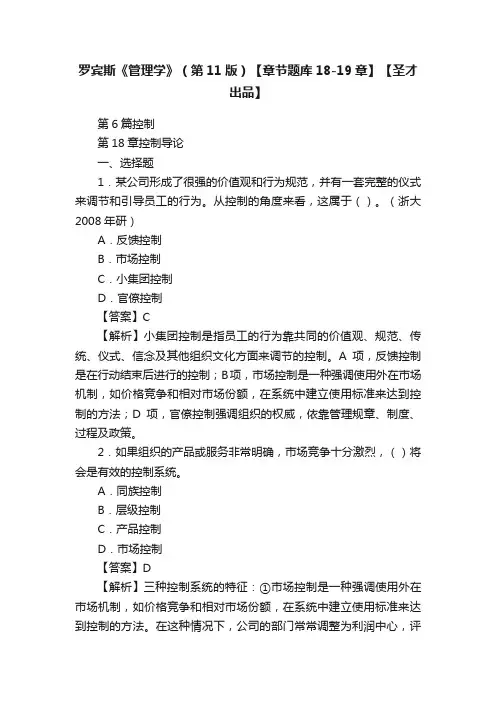
罗宾斯《管理学》(第11版)【章节题库18-19章】【圣才出品】第6篇控制第18章控制导论一、选择题1.某公司形成了很强的价值观和行为规范,并有一套完整的仪式来调节和引导员工的行为。
从控制的角度来看,这属于()。
(浙大2008年研)A.反馈控制B.市场控制C.小集团控制D.官僚控制【答案】C【解析】小集团控制是指员工的行为靠共同的价值观、规范、传统、仪式、信念及其他组织文化方面来调节的控制。
A项,反馈控制是在行动结束后进行的控制;B项,市场控制是一种强调使用外在市场机制,如价格竞争和相对市场份额,在系统中建立使用标准来达到控制的方法;D项,官僚控制强调组织的权威,依靠管理规章、制度、过程及政策。
2.如果组织的产品或服务非常明确,市场竞争十分激烈,()将会是有效的控制系统。
A.同族控制B.层级控制C.产品控制D.市场控制【答案】D【解析】三种控制系统的特征:①市场控制是一种强调使用外在市场机制,如价格竞争和相对市场份额,在系统中建立使用标准来达到控制的方法。
在这种情况下,公司的部门常常调整为利润中心,评价的标准是各自对公司利润贡献的百分比。
②官僚控制,它强调组织的权威,依靠管理规章、制度、过程及政策。
③小集团控制,员工的行为靠共同的价值观、规范、传统、仪式、信念及其他组织文化方面的东西来调节。
3.Z公司在将制造环节外包给某地一家企业时,为了防止潜在的质量问题,在生产线还没有建成之前就开始培训对方的工艺技术人员和质量检验人员。
从控制的角度来看,这属于()。
(浙大2007年研)A.反馈控制B.现场控制C.前馈控制D.同期控制【答案】C4.关于组织控制,下列哪种说法是正确的?()A.有效的控制系统有利于员工的授权B.制定组织结构对于控制活动非常关键C.人力资源管理属于控制职能D.组织的战略是在控制阶段制定的【答案】A【解析】许多管理者不愿意向自己的员工授权,因为他们害怕如果发生什么差错,将由他们来承担责任。
罗宾斯《管理学》课后习题答案第Ⅰ篇绪论第一章管理与组织导论一、谁是管理者1.管理者在哪些方面不同于非管理人员?答:协调其他人的工作——区分了管理岗位与非管理岗位。
2.说明为什么并不总能很容易地确定谁是组织中的管理员。
答:组织以及工作正在变化的性质模糊了管理者与非管理雇员之间的界限,许多传统的职位现在都包括了管理性的活动,特别是在团队中(团队成员通常要制定计划、决策以及监督自己的绩效),非管理雇员也承担着过去是管理者的一部分职责。
补充:⑴管理者:管理者是这样的人,他通过协调其他人的活动达到与别人一起或者通过别人实现组织的目标。
3.对比三种不同的管理层次。
答:①基层管理者是最低层的管理人员,他们管理着非管理雇员所从事的工作,这些工作生产和提供组织的产品。
②中层管理者包括所有处于基层和高层之间的各个管理层次的管理者,这些管理者管理着基层管理者。
③高层管理者处于或接近组织顶层,他们承担着制定广泛的组织决策、为整个组织制定计划和目标的责任。
注:并不是所有的组织都具有金字塔形的组织结构,但都需要某个人来扮演管理者的角色,即需要有人来协调工作和活动,以便能够同别人一起或者通过别人来实现组织的目标。
二、什么是管理补充:⑴管理:定义为一个协调工作活动的过程,以便能够有效率和有效果地同别人一起或通过别人实现组织的目标。
要点:①过程代表了一系列进行中的有管理者参与的职能或活动,这些职能一般划分为计划、组织、领导和控制。
②协调其他人的工作——区分了管理岗位与非管理岗位。
③有效率和有效果地完成组织的工作活动。
4.如何理解管理是一个过程。
答:上面要点①。
5.定义效率和效果。
答:①效率是指以尽可能少的投入获得尽可能多的产出。
通常指的是“正确地做事”,即不浪费资源。
②效果通常是指“做正确的事”,即所从事的工作和活动有助于组织达到其目标。
③可见,效率是关于做事的方式;效果是指实现组织目标的程度,涉及事情的结果。
6.解释效率和效果对管理的重要性。
第六章一、名词解释1.需要层次理论:需要是激励人们努力工作的因素,人只有低层次的需要得到满足,才会有高层次的需要。
马斯洛把人类的需要归为五大类,即生理需要、安全需要、社交的需要、尊重的需要和自我实现需要。
2.双因素理论:赫茨伯格认为引起人们工作动机的因素主要有两个:一是激励因素,二是保健因素。
只有激励因素才能够给人们带来满意感,而保健因素只能消除人们的不满,但不会带来满意感;3.激励:激励的原意是指人在一定的外部刺激下出现的心理紧张状态。
管理学中的激励,是指管理者运用各种管理手段,刺激被管理者的需要,激发其动机,使其朝所期望的目标前进的心理过程。
4.领导方式:领导方式指领导者与被领导者之间发生影响和作用的方式。
管理学家利克特提出“专制-权威式”、“开明-权威式”、“协商式”、“群体参与式”四种形式。
二、单选题1.A;2.C;3.C;4.C;5.D;6.D;7.C;8.C;9.C;10.C三、多选题1.ACD;2.BCD;3.CD;4.BD;5.BCDE;四、简答题1.(1)领导是指激励、引导和影响个人或组织,在一定条件下实现组织目标的行动过程。
(2)从行为方式上看领导和管理都是一种在组织内通过影响他人来实现组织目标的协调活动的过程。
领导与管理的区别:时空观不同;对风险的态度不同、用人标准不同;处理问题的方法不同。
2.权力是一个人影响他人的能力。
具体包括以下几方面内容:①权力是依赖的函数;②假定了人们对自己的行为有一定的自主权;③权力是潜在的,无需借助其他来证明自己的有效性。
权力的类型包括以下几种:强制权、奖赏权、法定权、专家权和感召权。
3.领导特质理论研究重点在于找出杰出领导者所具备的某些共同的特性或品质上,认为领导工作效能的高低与领导者的素质、品质或个人特性密切相关,即领导者的个人特质是决定领导效能的关键因素。
反映有效领导者特性的个性特征包括:进取心、领导愿望、诚实与正直、自信、智慧、工作相关知识。
管理学基础,第八版,(罗宾斯等)第六章组织结构与组织设计1)组织设计是管理者改变或开发组织结构的过程。
答案:正确解释:根据定义,组织设计要求一个管理者通过某种途径来开发或改变一个组织的结构。
难度:2参考页:132目标内容:6.1学习目标:讨论影响组织结构决策的因素2)组织结构有四个基本要素。
答案:错误解释:共有六个要素:工作专门化、部门划分、职权与职责、管理幅度、集权与分权、规范化难度:1参考页:132目标内容:6.1学习目标:讨论影响组织结构决策的因素3)由法约尔和韦伯提出的有关组织设计的早期观点现在大部分已经过时了。
答案:错误解释:令人惊奇的是,法约尔与韦伯有关组织设计的许多观点今天仍然有效。
难度:2参考页:132目标内容:6.1学习目标:总结历史上和当前的主要管理方法4)20世纪早些时候,当工作专门化最初展开实施时,员工的工作效率开始提高。
答案:正确解释:最初,管理者发现专业化导致了效率的大幅提高;然而,当工作变得过度专业化时,员工士气和激励下降,消除了许多由效率提高所带来的收益。
难度:2参考页:133目标内容:6.1学习目标:讨论影响组织结构决策的因素5)今天,大部分管理者将工作专门化看做是一种持续提高效率的源泉。
答案:错误解释:没有使员工失去热情的专业化往往成效最好;千篇一律的流水线工作可能造成收益递减。
难度:2参考页:133目标内容:6.1学习目标:讨论影响组织结构决策的因素6)工作专门化的益处在于它往往带来高员工激励和高效率。
答案:错误解释:情况正好相反——过多的工作专门化导致低激励和低效率。
难度:2参考页:133目标内容:6.1学习目标:讨论影响组织结构决策的因素7)部门划分是指工作是如何分组的。
答案:正确解释:部门划分被定义为将工作依据功能、产品或其他标准进行分组。
难度:1参考页:134目标内容:6.1学习目标:讨论影响组织结构决策的因素8)参谋职权是可以指导任何不具备组织中更高阶职位的员工的工作的能力。
管理学第六章习题及答案⼀、习题(⼀)填充题1、决策就是计划的前提,计划就是决策的____逻辑延续_____。
2、计划的编制过程,既就是决策的___组织落实过程______,也就是决策的更为详细的检查与修订的过程。
3、所有层次的、不同职能的管理⼈员都要做计划⼯作,这反映了计划的___普遍______性;同时计划⼯作要求纵向层次性与横向协作性,这反映了计划⼯作的____秩序_____性。
4、计划⼯作的⽬的就就是使____所有的⾏动保持同⼀⽅向_____,促使组织⽬标实现。
5、计划⼯作的普遍性中蕴含着⼀定的秩序,最主要的秩序表现为计划⼯作的____纵向协作性_____与____横向协作性_____。
6、在衡量代价时,不仅⽤时间、⾦钱或者⽣产等来衡量,⽽且还有衡量____个⼈与集体的满意程度_____。
7、计划就是将决策实施所需完成的活动任务进⾏____时间与空间_____上的分解,以便将其具体地落实到组织中的不同部门与个⼈。
8、根据综合性标准,可以把计划分为___战略性计划______与___战术性计划______。
9、根据___职能空间______标准,可以把计划分为业务计划,财务计划,⼈事计划。
10、战略性计划就是战术性计划的_____依据____。
11、战术性计划就是在战略性计划的指导下制定的,就是战略性计划的____落实_____。
12、常规计划包括___政策______、__标准⽅法_______与___常规作业程序______,所有这些都就是准备⽤来处理常发性问题的。
13、____⾯向未来_____与_⾯向⾏动________就是计划的两⼤显著特征。
14、⽬标结构描述了组织中各层次⽬标间的___协作关系______。
(⼆)选择题1、____AB_____的计划就是有效率的。
A、能得到最⼤的剩余B、能以合理的代价实现⽬标C、成本等于收益D、详细2、根据计划的明确性,可以把计划分类为___C_____。
第一章1.是的。
他也要进行计划,组织,领导,控制。
他是一个领导者和监听者。
他拥有沟通技能和人际技能。
2.因为每一个组织都有自己的目标,目标的体现就表现在员工的绩效,所以说管理者的最基本的职责是关注员工的工作绩效。
还应注重效率。
3.职位候选人的技能分为技术技能,人际技能和概念技能。
作为雇主他不可能同时所有能力,所以雇主需要聘请其他人来帮忙。
这给我的启示是要提升自己各方面的能力。
4.没有的。
管理是一门艺术,每个人都有自己的特色,没有最佳的。
如果有最佳的,人们不就都往这方面发展了,那有什么意思。
5.新型组织的动态,灵活性,根据任务定义工作,团队导向等特征有兴趣。
因为这些特征可以促使企业更灵活,能够根据市场情况更快的作出反应。
有利于提高雇员的劳动积极性,促进雇员间的团队意识,合理高效地完成任务。
但我对雇员参与决策制定,在任何地点、任何时间工作,工作日长没有限制等特征不感兴趣。
因为如果过多的给予员工太多的自由,不仅不会使他们的工作效率上升,反而还会让他们感到没有压力,进而变得懒散,工作效率反而会下降。
并且过于宽松的环境也不利于管理者的管理。
而雇员参与决策的制定在一定程度上可以团结员工,但却会带来很大的弊端,因为雇员的思考方向是有利于自己的,而不会考虑整个企业的发展,并且雇员无法了解企业的整体情况,不能作出最好的决策。
不过总体上来说,新型组织在原有的基础上取得了很大的进步。
6.在今天的环境中,单从效率和效果而言,效果对组织更重要。
因为效果通常是指“做正确的事”,即所从事的工作和活动有助于组织达到其目标。
而效率是指以尽可能少的投入获尽可能多的产出。
在如今的社会中,具有高效率和高效果则企业将立于不败之地,正如UPS。
但要在二者择其一时,效果显然更重要,如果所做的工作不能达到组织的目标,那么所做的事就等于白做,即使是再高的效率也没用。
就像以前中国的很多企业虽然资源利用率低,但只要能达到顾客的要求,它们仍然能够在市场上生存。
管理学基础各章自测练习含答案第一章管理和管理学一、单项选择1.在管理的各项职能中,最具有规范性、技术性的职能是( +)。
+.计划 +.组织 +.领导 +.控制2.“管理就是决策”是下列哪位经济学家的观点?( +)+.泰罗 +.法约尔 +.西蒙 +.韦伯3.“凡事预则立,不预则废”,说的是( +)的重要性。
+.组织 +.预测 +.预防 +.计划4.组织是管理的基本职能之一,它是由(+)三个基本要素构成。
+.目标、原则和结构 +.目标、部门和效率+.目标、部门和关系 +.目标、部门和人员5.为了保证计划目标得以实现,就需要有控制职能,控制的实质就是使(+ )。
+.实践活动符合于计划 +.计划接近实际活动+.实践活动具有指标约束 +.计划得以严格执行6. 当管理者接待来访者、参加剪彩仪式等社会活动时,他行使的是(+ )的角色。
+.发言人 +.组织联络者 +.领导者 +.精神领袖7.对于基层管理者来说,具备良好的( +)是最为重要的。
+.人际技能 +.概念技能 +.技术技能 +.管理技能二、多项选择1.管理作为一种特殊的实践活动,具有其独特的性质,比如()。
+.管理具有二重性 +.管理具有科学性+.管理具有艺术性 +.管理具有时效性2.关于高层、中层和基层管理者三者之间的关系,可以描述为:()。
+.他们所履行的管理职能是相同的+.高层管理者花在计划职能上的时间要比基层管理者多+.高层管理者花在控制职能上的时间要比基层管理者少+.基层管理者花在领导职能上的时间要比高层管理者多3.明茨伯格通过实证研究发现:管理者在组织中扮演十种角色,这些角色被分为()。
+.人际关系角色 +.组织角色 +.信息角色 +.决策角色4.管理者在行使各种管理职能、扮演三类管理角色时,必须具备以下技能:如()。
+.信息技能 +.技术技能 +.人际技能 +.概念技能5.对某一特定社会中的所有组织都发生影响的环境因素就是宏观环境,它主要包括( + )。